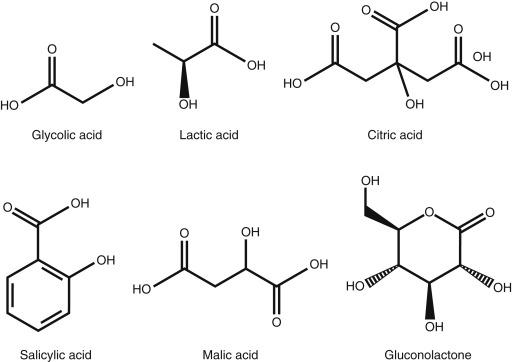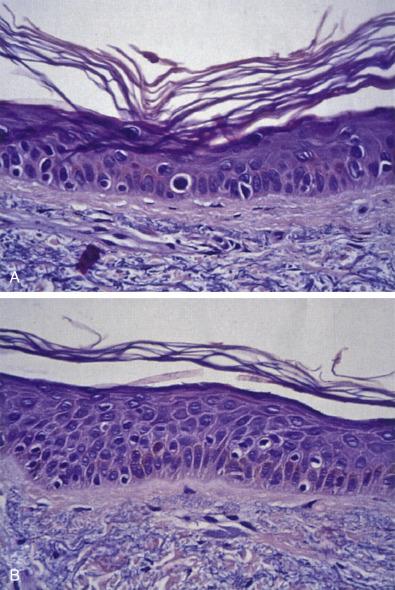Physical Address
304 North Cardinal St.
Dorchester Center, MA 02124
Q52.1 What are the primary epidermal and dermal effects from α-hydroxy acids (AHA) that lead to clinical benefit in various cutaneous disorders? ( Pg. 586x2 )
Q52.2 What are examples of the polyhydroxy acids (PHA), and what advantage do these chemicals offer compared with the α-hydroxy acids? ( Pgs. 587, 588 )
Q52.3 What are the primary microscopic and clinical differences noted with photodamaged skin after treatment with AHA? ( Pg. 587 )
Q52.4 When administering a chemical peel or starting an AHA in a skin care regimen, how do (1) skin type, (2) level of environmental damage, and (3) current skin care regimen affect how physicians must select the AHA concentration and the duration of the chemical peel? ( Pg. 588x2 )
Q52.5 Considering their differing mechanisms of action, how do (1) tretinoin, and (2) AHA assist in the treatment of acne? ( Pgs. 588x2, 589x3 )
Q52.6 What are the AHA concentration and pH ranges in each of the following three tiers: (1) retail formulations, (2) professional products, and (3) formulations for medical use only by a physician? ( Pgs. 589, 590 )
Q52.7 How does the pH of the AHA product relate to the amount of free acid, and the resultant irritancy of the product? ( Pgs. 589, 590 )
Q52.8 What are some of the measures clinicians can use to decrease irritancy from using AHA? ( Pg. 590x2 )
Q52.9 What effect does glycolic acid have on sun sensitivity and photocarcinogenesis and what are some of the measures clinicians can use to reduce the risk? ( Pg. 590x3 )
α-Hydroxy acid
β-Hydroxy acid
Cosmetic Ingredient Review
US Food and Drug Administration
Glycosaminoglycan
Minimal erythema dose
Molecular weight
Polyhydroxy acid
Ultraviolet B
α-Hydroxy acids (AHA) are a class of compounds that continue to generate extensive media attention and consumer interest for their use in the treatment of xerosis, icthyosis, photodamage, acne, and pigmentary disorders, to name a few. Since their introduction to the market in the 1970s, AHA have transformed dermatologists’ approach to skin care. The AHA most commonly used are lactic acid and glycolic acid. AHA are naturally occurring compounds derived from ‘fruit acids’ (citric and malic acid), sugarcane (glycolic acid) or milk (lactic acid); however, the AHA used in clinical practice are typically chemically synthesized. Some of their most touted benefits are for improvements in the appearance of photodamaged skin. This chapter will summarize the major classes of hydroxy acids including pharmacology, mechanism of action, clinical indications and adverse effects (AE).
AHA are weak organic acids, chemically distinguished by one or more hydroxyl group covalently bonded to the α-carbon of a carboxylic acid. This structure accounts for the water-soluble, or hydrophilic, properties of AHA. The smallest of the AHA are the monocarboxylic acids—glycolic (2-hyxroxyethanoic acid), lactic (2-hydroxy-propanoic acid), and mandelic acid (2-hydroxy-2-phenylethanoic acid). Glycolic acid is the 2-carbon molecule that conforms to the formula HOCH 2 COOH ( Fig. 52.1 ). The advantages of glycolic acid are that it is stable, colorless, odorless, water-soluble, and nontoxic if ingested. Lactic acid, has a 3-carbon chain; the formula is shown in Fig. 52.1 . Lactic acid can exist in several isomeric forms: the L (+) (levorotatory), the D (−) (dextrorotatory), or the dl racemic mixture. The L (+) for is the naturally occurring isomer, while the D (−) and racemic mixture can be produced through fermentation by certain bacterial strains. The two types have been shown to have equal effectiveness. Additional subcategories of AHA include dicarcoxylic acids (malic and tartaric acid) and tricarboxylic acids (citric acid), which are larger with longer carbon chains. Higher molecular weight AHA (malic acid, citric acid, mandelic acid, tartaric acid) do not penetrate the stratum corneum as well as lower molecular weight AHA (glycolic and lactic acid).

PHA are longer carboxylic acids with two or more hydroxyl groups, one of which must be attached to the α position. Owing to their larger size, PHA have a slower rate of absorption into the skin. The principal PHA are gluconolactone, galactose, and lactobionic acid. Galactose and gluconolactone contain four hydroxyl groups each, and lactobionic acid contains eight hydroxyl groups, allowing them to bind more water than the smaller AHA.
ß-Hydroxy acids (BHA) are carboxylic acids having one hydroxyl group attached to the ß-position of the carboxyl group. Some BHA are actually considered AHA as they also contain a hydroxyl group at the α-position, including citric acid and malic acid. Salicylic acid is sometimes incorrectly characterized as a BHA. This is because the hydroxyl group is attached to an aromatic phenol group, rendering the hydroxyl group acidic rather than neutral as in BHA. This chapter will not discuss BHA or salicylic acid extensively, but it is important to note that salicylic acid is lipophilic and able to penetrate into sebum-rich areas of the pores, making them a useful treatment in conditions like acne.
Q52.1 AHA efficacy derives from its ability to initiate corneocyte disadhesion by disruption of ionic bonds. Detachment of keratinocytes is induced by AHA promoting the degradation of corneodesmosomes leading to accelerating stratum corneum turnover. Although the exact mechanism of action is not fully understood, Wang and associates proposed that the topical application of AHA leads to a decrease in the calcium ion concentration in the epidermis. The reduced level causes a loss of calcium ions from the cell junctions, leading directly to exfoliation of corneocytes. As desquamation occurs, the AHA is able to penetrate to deeper levels of the epidermis and into even into the dermis. Histologic effects of AHA include a thinned stratum corneum with acanthosis. Decreased calcium ion levels induced by AHA may also promote cell proliferation and retard differentiation of keratinocytes.
When AHA are applied consistently, the effective regulation of keratinization yields a smoother, less scaly surface and improved appearance of xerotic or mature skin. Desquamation from follicular orifices helps to dislodge comedones and prevents follicular occlusion. However, AHA are unable to penetrate the follicular ostia. With application of AHA, patients commonly note control of dry skin, ichthyosis, and acne, along with improved appearance of solar lentigines. Higher concentrations of some AHA not only diminish corneocyte cohesion, but can reduce melanin synthesis. Overall, the properties of epidermal remodeling and pigment lightening make AHA potentially useful for treating photodamaged skin, xerosis, icthyosis, lentigines, macular seborrheic keratoses, actinic keratoses, verrucae, and acne, and for prevention of corticosteroid-induced atrophy.
Q52.1 With long-term use, the AHA produce measurable dermal changes ( Table 52.1 ). Dermal effects of AHA include increased dermal thickness, possibly because of fibroblast proliferation and increased collagen production. A controlled study using 25% glycolic, lactic, or citric acid to the forearm for 6 months showed an approximately 25% increase in skin thickness. Both the epidermis and papillary dermis were thicker without inflammation, with the dermis showing increased glycosaminoglycans (GAG), increased collagen density, disbursement of melanin, and improved quality of elastic fibers ( Fig. 52.2 ).
| Stratum Corneum Response | Epidermal and Dermal Response |
|---|---|
|
|

Data suggests that glycolic acid produces a functional activation of fibroblasts. In a study designed to evaluate the effect of glycolic and malic acids on cultured dermal fibroblasts, results showed an increase in cell proliferation and collagen production in response to glycolic acid in a dose-dependent manner, but showed minimal change with malic acid or control. In another study, Okano and associates found that glycolic acid directly increased collagen synthesis by fibroblasts, and regulated matrix degradation and collagen production through keratinocyte-released cytokines. The increase in type I collagen and intercellular ground substances (namely hyaluronic acid) leads to increased dermal hydration and thickness, and provides an aqueous environment for the diffusion of nutrients and toxins. For the treatment of photodamage, in addition to AHA effects on the epidermis mentioned above, AHA can also decrease the appearance of rhytides through these effects on the dermis.
Become a Clinical Tree membership for Full access and enjoy Unlimited articles
If you are a member. Log in here